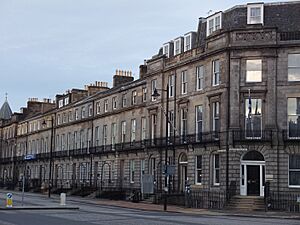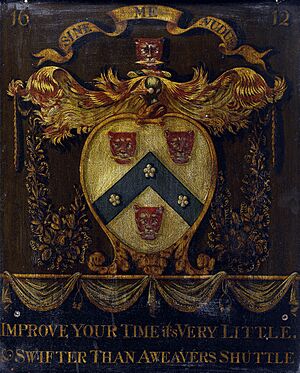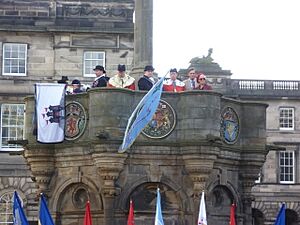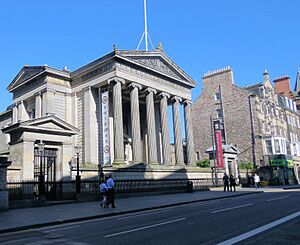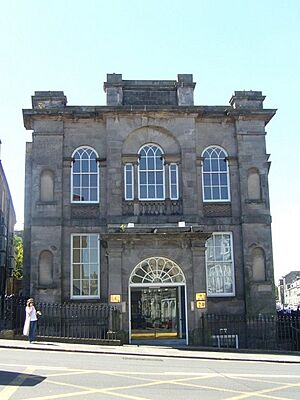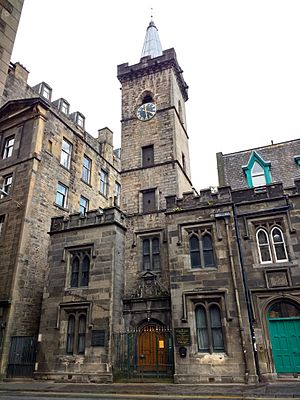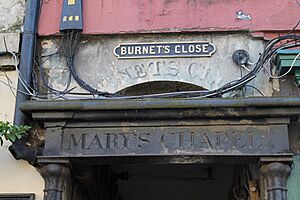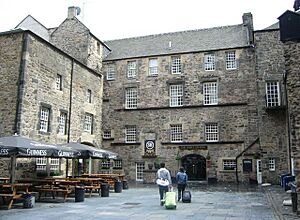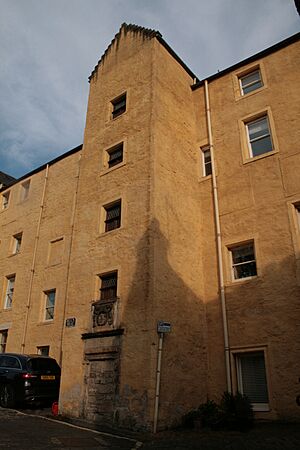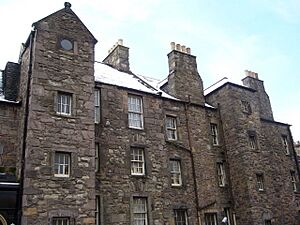Incorporated Trades of Edinburgh facts for kids
The Incorporated Trades of Edinburgh are special groups of skilled workers and craftspeople in Edinburgh, Scotland. Think of them like clubs for different jobs, such as bakers, blacksmiths, or tailors. These groups have a long history and are similar to the livery companies in London, but on a smaller scale.
In Scotland, these groups were called "incorporations," not "guilds." They were created hundreds of years ago, mostly in the late 1400s. They wanted to protect their members' interests against the powerful merchant groups of the city.
By 1562, all these craft groups joined together to form the Convenery of Trades of Edinburgh. This is like a big umbrella organization that still exists today. It supports all the different trade incorporations. The Convenery is made up of the leaders (called Deacons) from each group. It creates a friendly community for all the skilled workers, their employees, and their trainees.
To join one of these incorporations, a person first had to become a burgess, which is like being an official citizen of the city with special rights. Once a craftsman was accepted, they could start their own business, hire workers, and train apprentices. The incorporations made sure that only their members could practice a certain trade in Edinburgh.
Today, the Convenery of Trades is no longer officially part of the city government, but it still takes part in many of the city's important ceremonies and traditions.
Contents
What Are the Incorporated Trades?
The Incorporated Trades of Edinburgh were groups that controlled their specific crafts within the city. There are 15 of these incorporations. Fourteen of them have leaders called Deacons, who have been part of the Convenery of Trades from the very beginning.
Unlike in London, where groups are ranked by when they were founded, Edinburgh's trades were ranked by a special ruling from King James VI in 1583. This was because many of the groups had lost their original documents and didn't know when they had started.
For a long time, until 1833, the Deacons from the 14 main incorporations were part of the Town Council. This meant they helped make important decisions for the city. However, changes in local government in 1973 removed their official role in the City of Edinburgh Council.
The Convenery of the Trades of Edinburgh
The Convenery is the main body that governs all the Incorporated Trades. Today, its main job is to run charities and organize events. It is led by the Deacon-Convener, who is considered the most important tradesperson in Scotland and the third most important citizen of Edinburgh, after the Lord Provost (the city's mayor) and the Lord Dean of Guild.
For many years, the Convenery met in the historic Magdalen Chapel. Now, it has its own headquarters called Ashfield on Melville Street, which even includes a museum.
How to Join an Incorporation
In the past, to become a member (or "freeman") of a trade, you first had to become a burgess of Edinburgh. This was a special status granted by a city official. After a change in 1973, this process became more complicated for the trades.
To solve this, the City of Edinburgh Council helped the trades and the merchants create a new system. Now, both groups can nominate people to become burgesses. In 2017, the Burgess Association of Edinburgh was created to help manage this process and encourage friendship between the craftspeople and the merchants.
How the Trades Were Governed
The incorporations had a clear structure to manage their members and work.
Deacons: The Leaders of the Craft
Each trade group elects a leader called a Deacon. This position has existed since 1424. At first, the Deacon's main job was quality control. They made sure that everything their members made was of a high standard.
Later, Deacons also became trustees for charities. For example, they helped run the Edinburgh Trades Maiden Hospital, which was founded with Mary Erskine to help the daughters of craftsmen. This charity is now called the Edinburgh Trades Fund.
One of the most famous deacons was Deacon Brodie, who led the wrights (carpenters and cabinetmakers). He used his job to learn about people's homes and then became a thief at night. He was eventually caught and punished for his crimes.
The Boxmaster: Keeper of the Funds
Each incorporation had a special box where they kept their money and important papers. These boxes were often beautifully decorated. The person in charge of the box was called the Boxmaster, which was another name for the treasurer.
What Did the Trades Do?
The main purpose of the incorporations was to act as a trade association. They set rules to maintain high standards for their craft in the city. You couldn't work in a trade without being a member of its incorporation. This meant they also helped train new apprentices and journeymen.
As the trades became more powerful, they started to attract influential people. At first, most members were burgesses, but soon even lawyers and nobles joined. For example, in 1657, a lawyer named Charles Smith joined the Hammermen (metalworkers) by making a silver horseshoe.
The incorporations also became social clubs. The masons' group was called the Incorporation of Mary's Chapel because they met in a chapel of that name. In 1634, they allowed Sir Anthony Alexander, who was not a working stonemason, to join their lodge. This is seen by some as an early step toward modern Freemasonry. Because of this and their old records, the Lodge of Edinburgh (Mary's Chapel) No. 1 claims to be the oldest Freemason's Lodge in the world.
The Trades Today
Today, many of the trades focus on charity work. Some of the most well-known incorporations have evolved into major institutions.
- The Incorporation of Surgeons is now the famous Royal College of Surgeons of Edinburgh. It is one of the most important surgical colleges in the United Kingdom and Ireland.
- The Incorporation of Goldsmiths owns and runs the Edinburgh Assay Office. It still has the legal role of testing and marking gold, silver, and other precious metals before they can be sold.
Important Ceremonies
The trades continue to take part in historic city events.
The Kirking of the Deacons
Every year, the new Deacons are officially recognized in a church ceremony called the Kirking of the Deacons. They march in their ceremonial robes to Greyfriars Kirk, led by an officer carrying a famous banner called the Blue Blanket. The Lord Provost of Edinburgh meets them, and a special service is held.
The Riding of the Marches
The Riding of the Marches is an annual event that revives an old tradition. It remembers the return of a city captain in 1513 with news from the Battle of Flodden. The captain brought back the Blue Blanket banner, which had been given to the city's craftsmen by King James III in 1482.
List of the Main Incorporations
The ranking of the incorporations was set by King James VI in 1583. Here they are in order of importance:
- 1. The Incorporation and Royal College of Surgeons
- 2. The Incorporation of Goldsmiths
- 3. The Incorporation of Skinners (leather workers)
- 4. The Incorporation of Furriers (fur workers)
- 5. The Incorporation of Hammermen (metalworkers)
- 6. The Incorporation of Wrights (carpenters)
- 7. The Incorporation of Masons (stonemasons)
- 8. The Incorporation of Tailors
- 9. The Incorporation of Baxters (bakers)
- 10. The Incorporation of Fleshers (butchers)
- 11. The Incorporation of Cordiners (shoemakers)
- 12. The Incorporation of Weavers
- 13. The Incorporation of Waulkers (cloth fullers)
- 14. The Incorporation of Bonnetmakers & Dyers
- 15. The Incorporation of Candlemakers
Historic Meeting Halls
Each incorporation had its own hall for meetings and administration. Many of these historic buildings can still be seen in Edinburgh today.
| Incorporation | Image of hall | Hall | |
|---|---|---|---|
| Incorporation and Royal College of Surgeons |
Surgeons' Hall - The current hall was designed by William Henry Playfair and finished in 1832. The Old Surgeons' Hall from 1697 is in Surgeons' Square. | ||
| Incorporation of Goldsmiths |
Goldsmiths Hall - Located on Broughton Street. It is a former church that was opened as the assay office in 1999. | ||
| Incorporation of Skinners |
Skinners Hall - This hall dates from 1643. It is now privately owned and has been converted into apartments. | ||
| Incorporation of Hammermen |
Magdalen Chapel - Located in the Old Town, it was built between 1541 and 1544. The Hammermen owned it until 1858. | ||
| Incorporation of Masons |
Their first hall, St Mary's Chapel, was demolished in the 1780s. They moved to a new hall on Burnet's Close, also called Mary's Chapel. | ||
| Incorporation of Tailors |
Tailor's Hall - Located in the Cowgate, the building was finished in 1621. It is now used as a hotel. | ||
| Incorporation of Baxters |
The old Tolbooth in Dean Village, originally built as a granary in 1675. | ||
| Incorporation of Candlemakers |
Candlemakers Hall - Built in 1722 on Candlemakers Row, near Greyfriars Kirk. |
See also
- Merchant Company of Edinburgh
- City of Edinburgh Council
- Livery company


